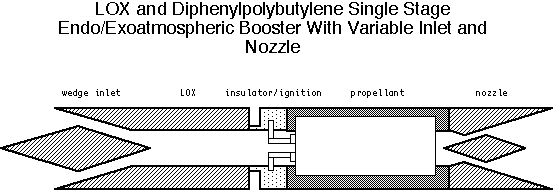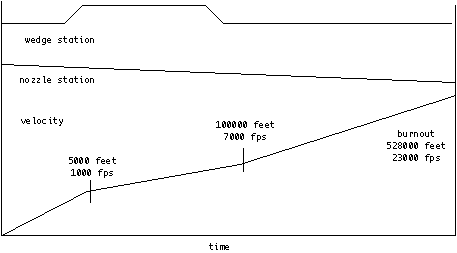A Grapefuit weighs about a pound. If we launched grapefruit sized instrument packages weighing about a pound into low earth orbit, we could create color maps of the earth. Weather spacecraft can't create accurate color maps of the earth because the weather boys didn't bother to put a blue sensor on board the NOAA and TIROS-N series spacecraft, not for the past 35 years anyway. Shuttles get busy doing other things and loose track of looking at the ground, especially when they come home. So we have to do that. Here's how.
Let's assume that we can put 1 of a percent of our launch weight into orbit. If we put 1 percent of our launch weight into orbit, then a grapefruit sized instrument package could be lofted by a vehicle weighing 100 pounds.
There is an astronomy club here, telescopes galore. Refractors and reflectors. The refractors and reflectors set up their telescopes and stare at the sky with lots of wishful thinking. One fellow was different. He brought a rocket motor to the meeting. He lit it up and made real rocket noises. That was more interesting. Better yet, his his was simple, elegant, safe, legal and THROTTLEABLE.
His rocket motor used a hollow tube (cylindrical annulus) made of molded rubber (polybutylene). Butylene monomer is cheap. It comes in big 55 gallon drums.

You mix up a batch, add a catalyst, pour it into a mold and viola, non-toxic, non-flammable, non-explosive rocket motor core. Cleaning up the drippings is a hassle, but newspaper is cheap. The core must be hollow, because as Von Karman and the Pasadena boys found out, you can't light a solid rocket motor from the end.
To light it you pump oxygen down the center of the tube, and add a spark. For the sake of argument we will assume this is Liquid OXygen. As long as the LOX is on, the motor stays lit. Yeah, yeah, you have to have a positive ignition system, but spark plugs and coils are not a problem, right? Anyway, increasing oxygen flow increases thrust by a corresponding amount. If you want to coast, you turn down the oxygen. You need a controller to monitor combustion pressure.
Reliable endoatmospheric (mmemonic: "in da atmosphere") operation requires spiking the propellant with supplementary oxidant. The interested reader can calculate the volume ratio of the propellant annulus and the LOX tank and send it to me at the address below. If you get the answer right, you're on an official, "grapefruit" rocket club member.
Don't waste LOX during the first 100,000 feet: I've added a movable wedge inlet (an idea I stole from Herman Krier's integral rocket ramjet notes) that can be opened at Mach 0.8 to supplement the burn. Using external air is a different game than LOX - a 78% nitrogen diluent affect combustion characteristics - so it will be necessary to characterize the motor and use a solid state controller with atmospheric property tables burned into a PROM, or gate array, or whatever works.

A typical launch sortie might look like:

At time zero we launch, running on pure LOX and rubber. As we gain velocity we encounter an altitude, velocity station where we can open the diamond wedge inlet. We slowly open and adjust the burn conditions while continuing to accelerate. At around 100,000 feet and Mach 7 (or so) we pull the wedge shut again as there is no longer any free oxygen working on our behalf. We continue to accelerate to burnout and orbital injection at approximately 528,000 feet and 23000 feet per second give or take and release the grapefruit. Navigation courtesy of GPS. Digital data stream courtesy JVC GR cam in an 1 atm. low humidity housing. The grapefruit opens it's eyes and starts recording earth data, then for grins we deorbit the camera and recover it. What could be more fun than that?